The main part of this pub (fronting onto Charing Cross Road) was built in 1911 by Montagu Pyke as his 16th (and last) cinema.
A plaque commemorating The Montagu Pyke.
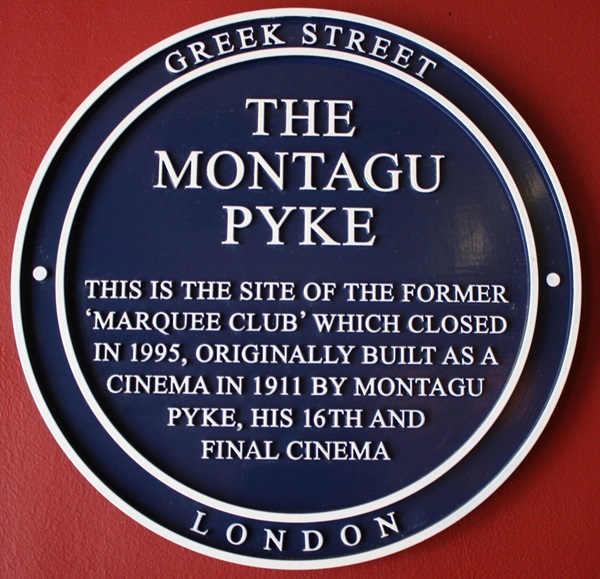
The plaque reads: This is the site of the former ‘Marquee Club’ which closed in 1995, originally built as a cinema in 1911 by Montagu Pyke, his 16th and final cinema.
A framed print and text about Montague Alexander Pyke.
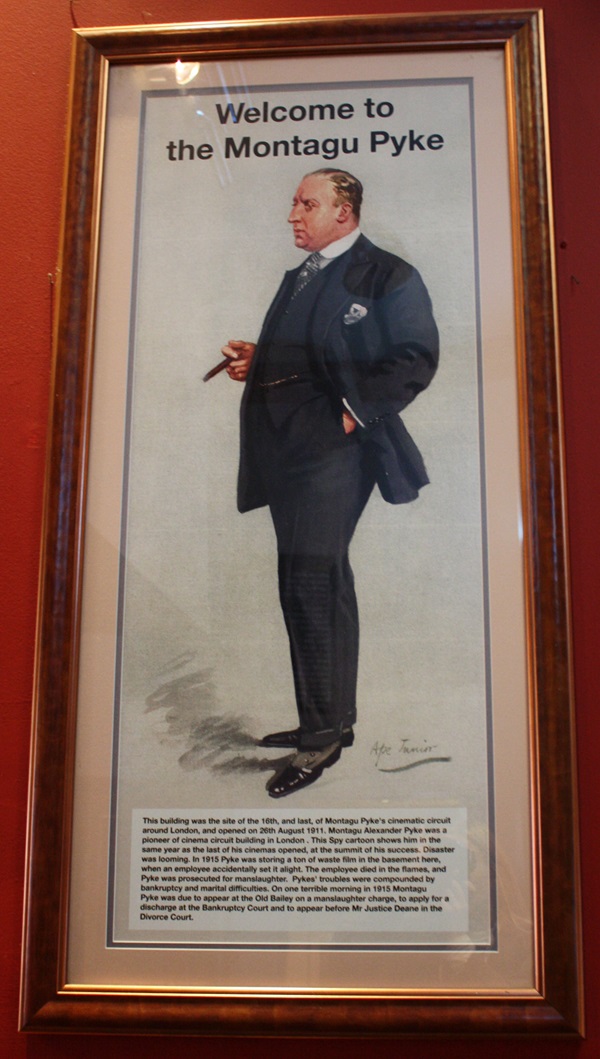
The text reads: The building was the site of the 16th, and last, of Montague Pyke’s cinematic circuit around London, and opened 26th August 1911. Montague Alexander Pyke was a pioneer of cinema circuit building in London. This spy cartoon shows him in the same year as the last of his cinemas opened, at the summit of his success. Disaster was looming. In 1915 Pyke was storing a ton of waste film in the basement here, when an employee accidentally set it alight. The employee died in the flames, and Pyke was prosecuted for manslaughter. Pyke’s troubles were compounded by bankruptcy and material difficulties. On one terrible morning in 1915 Montagu Pyke was due to appear at the old bailey on a manslaughter charge, to apply for a discharge at the Bankruptcy Court and to appear before Mr Justice Deane in the Divorce Court.
Framed drawings and text about the Soho Fields.
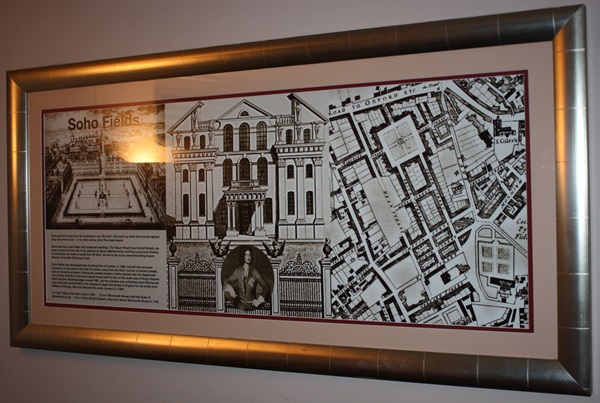
The text reads: Soho gets its name from the huntsman’s cry “So-Hoe”, that went up when the hounds sighted prey and broke cover – or in other words, when the chase began.
Soho was then the open fields with scattered dwellings. The Tyburn Road (now Oxford Street), ran east to west from the city to the gallows at Tyburn (Marble Arch), and Hog Lane (now Charing Cross Road), ran north to south from St Giles’ church to the cross commemorating Queen Eleanor of Castille (Charing Cross).
Soho Fields was developed after the Great Fire of London, in 1666, had left rich and poor homeless. A new start to the west of London, away from the City’s warren of ancient streets, was an attractive prospect. Among the earliest leaders of Soho society was the illegitimate son of King Charles II, who had a grand house built for him on the south side of King’s Square (Soho Square). Building began around 1681, but the mansion was unfinished when Monmouth was executed, having failed in his attempt to regain the throne of England for his family from William of Orange, who had deposed his uncle, James II, in 1680.
Far right: Map of Soho Area in 1681
Centre: Monmouth House, with the Duke of Monmouth (inset)
Above: Soho (King’s Square, view from above Monmouth House 1754
Framed photographs, drawing and text about Sir Joseph Banks.
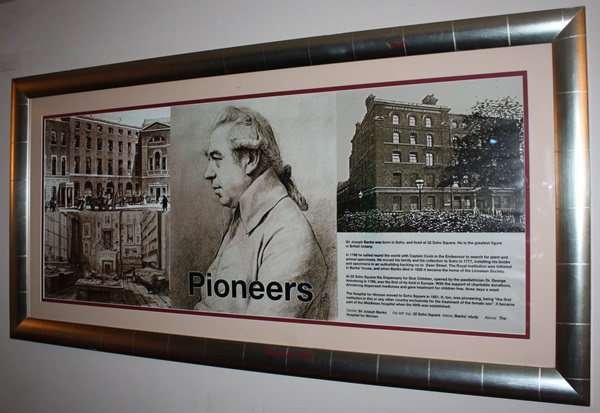
The text reads: Sir Joseph Banks was born in Soho, and lived at 32 Soho Square. He is the greatest figure in British botany.
In 1768 he sailed round the world with captain Cook in the Endeavour to search for plant and animal specimens. He moved his family and his collection to Soho in 1777, installing his books and specimens in an outbuilding backing on to Dean Street. The Royal Institution was initiated in Banks’ house, and when Banks died in 1820 it became the home of the Linnaean Society.
At 22 Soho Square the Dispensary for Sick Children, opened by the paediatrician Dr. George Armstrong in 1769, was the first of its kind in Europe. With the support of charitable donations, Armstrong dispensed medicines and gave treatment for free, three days a week.
The Hospital for Women moved to Soho Square in 1851. It, too, was pioneering, being “the first institution in this or any other country exclusively for the treatment of the female sex”. It became part of the Middlesex hospital when the NHS was established.
Centre: Sir Joseph Banks
Far left: top, 32 Soho Square, below, Banks’ study
Above: The Hospital for Women
Framed photographs and text about the Marquee Club.
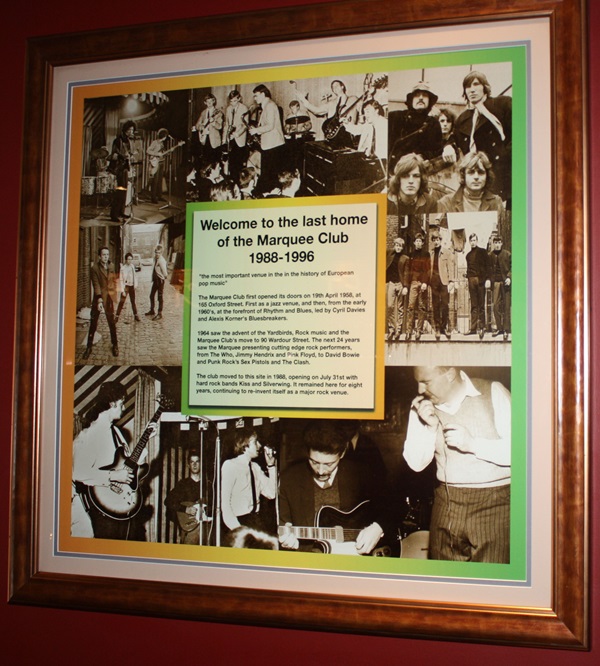
The text reads: “the most important venue in the history of European pop music”
The Marquee Club first opened its doors on the 19th April 1958, at 165 Oxford Street. First as a jazz venue, and then from the early 1960’s, at the forefront of Rhythm and Blues, led by Cyril Davies and Alexis Kroners’ Bluesbreakers.
1964 saw the advent of the Yardbirds, Rock music and the Marquee Club’s move to 90 Wardour Street. The next 24 years saw the Marquee presenting cutting edge rock performers, from the Who, Jimmy Hendrix and Pink Floyd, to David Bowie and Punk Rock’s Sex Pistols and The Clash.
The club moved to this site in 1988, opening on July 3st with hard rock bands Kiss and Silverwing. It remained here for eight years, continuing to re- invent itself as a major rock venue.
Framed photographs and text about rock bands.
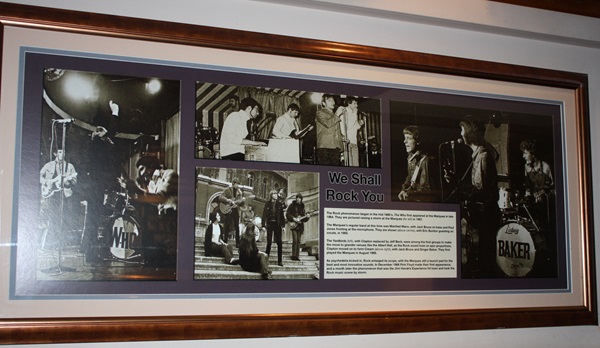
The text reads: The Rock Phenomenon began in the mid 1960’s. The Who first appeared at the Marquee in late 1964. They are pictured raising a storm at the Marquee (far left) in 1967.
The Marquee’s regular band at this time was Manfred Mann, with Jack Bruce on bass and Paul Jones fronting at the microphone. They are shown (above centre), with Eric Burdon guesting on vocals, in 1965.
The Yardbirds (Left), with Clapton replaced by Jeff Beck, were among the first groups to make the move grander venues like the Albert Hall, as the Rock sound took on epic proportions. Clapton moved on to form Cream (above right), with Jack Bruce and Ginger Baker. They first played the Marquee in August 1966.
As psychedelia kicked in, Rock enlarged its scope, with the Marquee still a launch pad for the best and most innovative sounds. In December 1966 Pink Floyd made their first appearance and a month later the phenomenon that was the Jimi Hendrix Experience hit town and took the Rock music scene by storm.
Framed photographs and text about heavy metal, glam-rock and punk artists.
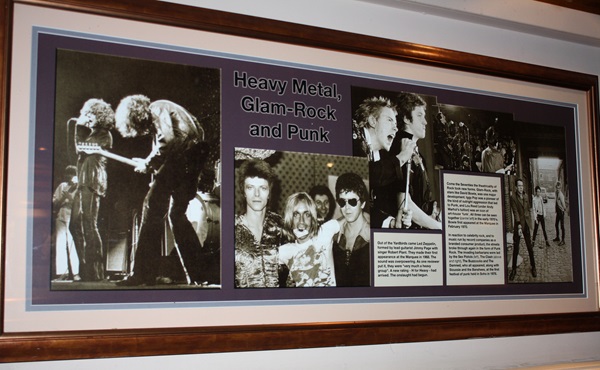
The text reads: Out of the Yardbirds came Led Zeppelin, formed by lead guitarists Jimmy Page with singer Robert Plants. They Made their first appearance at the Marquee in 1968. The sound was overpowering. As one reviewer put it, they were “very much a heavy group”. A new rating- H for Heavy – had arrived. The onslaught had begun.
Come the Seventies the theatricality of Rock took new forms. Glam-Rock, with stars like David Bowie, was one major development. Iggy pop was a pioneer of the kind of outright aggression that led to Punk, and Lou Reed (under Andy Warhol’s tuition) was an icon of art-house ‘funk’. All three can be seen together (centre left) in the early 1970’s. Bowie first appeared at the Marquee in February 1970.
In reaction to celebrity rock, and to music run by record companies as a branded consumer product, the streets broke through again in the form of Punk Rock. The invading barbarians were led by the Sex Pistols (left), The Clash (above and right), The Buzzcocks and The Damned, who all appeared, along with Siouxsie and the Banshees, at the first festival of punk held in Soho in 1976.
Modernised art of guitars and drums which refers to the history of the Marquee Club.
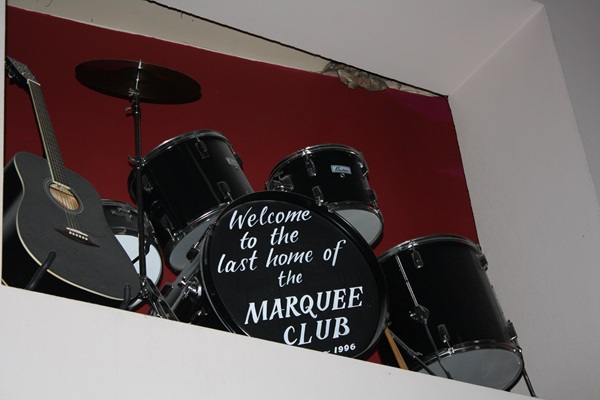
Internal photograph of the layout of the far end of The Montagu Pyke.
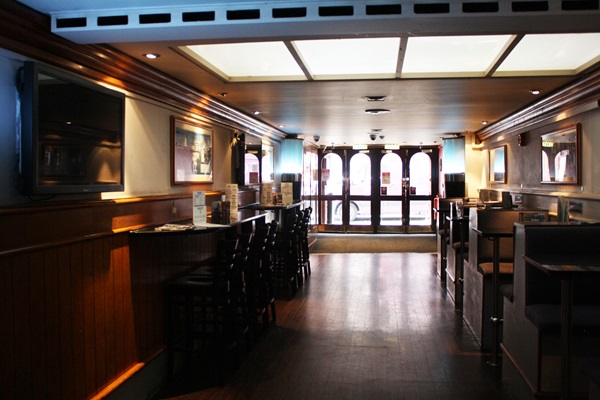
Internal photograph of a large projector, located at the back, which looks quite similar to the layout of the historic cinema theatre.
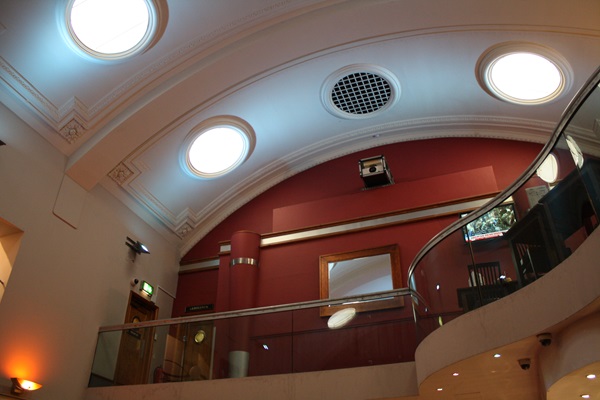
Photography of Montague Pyke’s historic, high and grand ceiling.
.jpg?h=400&&w=600&la=en&hash=2739E6C5348B602BECF61E2F02EA5F2E19E4D0E6)
External photograph of the building – main entrance.
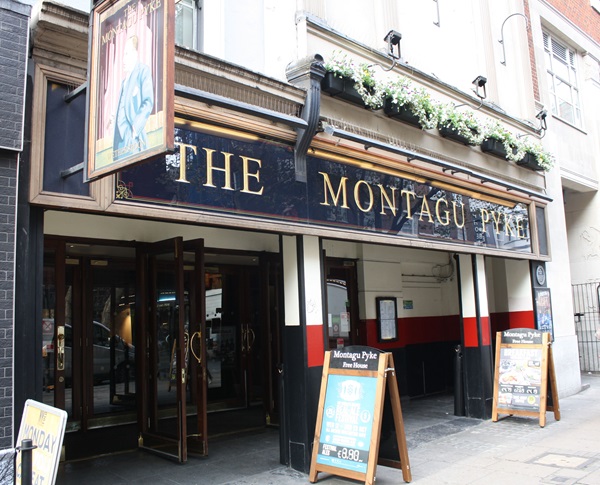
If you have information on the history of this pub, then we’d like you to share it with us. Please e-mail all information to: pubhistories@jdwetherspoon.co.uk